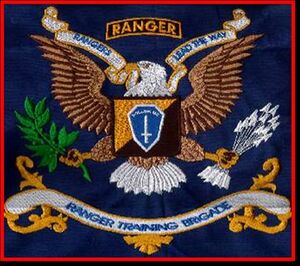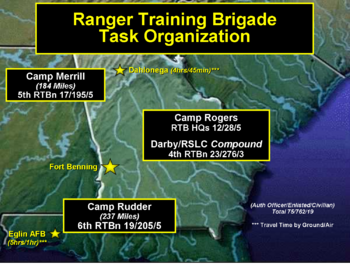Ranger School: Difference between revisions
Pat Palmer (talk | contribs) mNo edit summary |
mNo edit summary |
||
| Line 36: | Line 36: | ||
They will have 2-4 years as a small unit leader and undergo a 3-6 month certification process. Their background should indicate that Ranger School, as difficult as it may be, is a midpoint in professional development. | They will have 2-4 years as a small unit leader and undergo a 3-6 month certification process. Their background should indicate that Ranger School, as difficult as it may be, is a midpoint in professional development. | ||
===Further challenges=== | ===Further challenges=== | ||
As demanding as Ranger School may be, it is considered preparation for some of the [[special operations]] selection courses, as for [[Delta Force]]. [[United States Army Special Forces]] selection has some of the physical demands, but also has intense intellectual demands in operating in a simulated behind-the-lines guerrilla role. | As demanding as Ranger School may be, it is considered preparation for some of the [[special operations]] selection courses, as for [[Delta Force]]. [[United States Army Special Forces]] selection has some of the physical demands, but also has intense intellectual demands in operating in a simulated behind-the-lines guerrilla role.[[Category:Suggestion Bot Tag]] | ||
Latest revision as of 06:00, 10 October 2024
The United States Army Ranger School is a prestigious school in infantry tactics and small unit leadership. Many candidates do not complete it, and even completing it may not result in qualifying for the "Ranger Tab" badge. Headquartered at Fort Benning, Georgia, it is sometimes jokingly called the "Benning School for Boys", although it is the antithesis of child's play.
One does not need to complete Ranger School as a prerequisite for assignment to the 75th Ranger Regiment, and, indeed, most junior soldiers assigned there go through an abbreviated Ranger Indoctrination Program.
It is an important milestone for combat arms officers and noncommissioned officers; United States Military Academy cadets sometimes attempt it in the summer between their junior and senior years. While the majority of places are reserved for combat arms, soldiers from certain combat support branches, such as military intelligence, may go through it, and, if they succeed, obtain considerable credibility with combat soldiers.
Even among combat troops, it both adds skills and confidence to the soldier, and also can resolve doubts about officers thought to be "staff", "politicians", or "intellectuals". GEN David Petraeus was suspect, to some "old Army" officers due to his doctorate from Princeton, but the fact that he was the only man ever to be first in his class at both the Ranger School and Command and General Staff College overcame many doubts.
Instructional goals
As much as any specific skill, the School is intended to help successful candidates find reserves within themselves. The instructional model is crawl-walk-run; while the motto "The only easy day was yesterday" comes from the United States Navy SEALs, it is apropos here. Ranger School never gets easier.
Candidates will internalize:
- I can operate tactically under extended/stressful conditions successfully
- I can lead men under those circumstances
- I understand field craft, drills and patrolling
While some Ranger techniques literally go back to Rogers' Rangers in the French and Indian War, there is specific training in advanced infantry techniques that are used in current combat situations:
- Urban fighting with combat outposts and convoys
- Determined opponents who will use suicide tactics
- Controlling close support to ground forces including artillery, close air support from fast aircraft, and precision support from AC-130 gunships
- Field medicine and casualty evacuation
The Course
The full course lasts for 61 days, during which candidates carry 65 to 90 pounds of equipment on 2200 calories per day. In some phases, they must get food from the land. They carry out over 200 miles of combat movements, on foot, with 0 to 5 hours of sleep per night, with peer and cadre evaluations.
The "crawl" phase begins in forest at Camp Darby, but "walk" is in mountainous terrain at Camp Merrill; most of the entries are by parachute jump. "Run" moves to jungle at Camp Rudder at Eglin Air Force Base, Florida, including airborne, air assault, small boat, and dismounted combat patrol operations in a low intensity combat environment against a well trained, sophisticated enemy.
Instructors
There is 1 instructor for each 9 candidates, every instructor having full Ranger qualification as a starting point. Typically, they will also have completed the Jump Master, Pathfinder, HALO parachutist; Pathfinder, Basic and Advanced Noncommissioned Officer Courses; Combat Lifesaver and Emergency Medical Technician; Demolitions; Survival, Evasion, Resistance and Escape (SERE); Expert Infantry Badge; SCUBA diver; and Assault Climber and Mountaineering qualifications.
They will have 2-4 years as a small unit leader and undergo a 3-6 month certification process. Their background should indicate that Ranger School, as difficult as it may be, is a midpoint in professional development.
Further challenges
As demanding as Ranger School may be, it is considered preparation for some of the special operations selection courses, as for Delta Force. United States Army Special Forces selection has some of the physical demands, but also has intense intellectual demands in operating in a simulated behind-the-lines guerrilla role.


